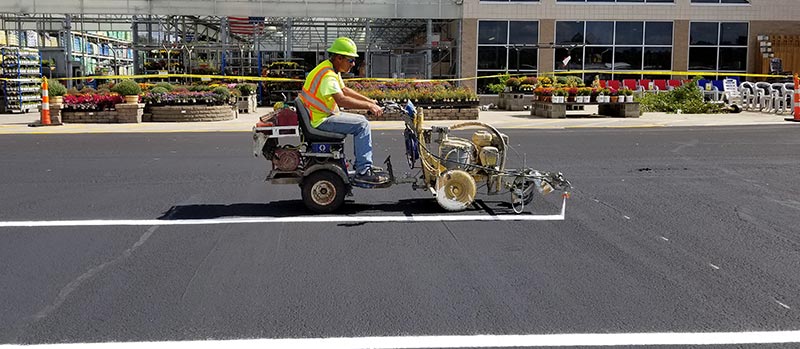Facts About A1 Professional Asphalt & Sealing Llc Uncovered
Facts About A1 Professional Asphalt & Sealing Llc Uncovered
Blog Article
Some Of A1 Professional Asphalt & Sealing Llc
Table of ContentsA1 Professional Asphalt & Sealing Llc Things To Know Before You Get ThisWhat Does A1 Professional Asphalt & Sealing Llc Mean?Not known Details About A1 Professional Asphalt & Sealing Llc The Single Strategy To Use For A1 Professional Asphalt & Sealing LlcThe smart Trick of A1 Professional Asphalt & Sealing Llc That Nobody is Discussing

The oil in a car engine is not simply oil. It has a selection of ingredients to boost the automobile's performance. These consist of polymers, viscosity modifiers, warmth stabilizers, added lubricants, and wear ingredients. The REOB includes all the ingredients that remained in the waste oil in addition to the wear steels from the engine (mostly iron and copper).
By making lots of blends utilizing various REOB examples and different asphalt binders, the variations mostly can be averaged out. Numerous States provided samples of well-known REOB make-up to TFHRC researchers, who assessed the samples to contrast the percent of added (known) REOB to the located (evaluated) quantity. The evaluations showed a comparable portion of included and found REOB.
Examine This Report on A1 Professional Asphalt & Sealing Llc
None of those States realized that the asphalt they were purchasing had REOB. One State urged its examples had no REOB - https://dc-washington.cataloxy.us/firms/a1asphaltpro.com.htm.
Of the 1,532 examples tested, 12 percent had REOB, and some contained significantly high degrees of it at 1020 percent. The highest degree was 34 percent in an example from Texas, which TxDOT had actually made use of in a patching compound. This screening additionally exposed the existence of phosphoric acid in 11 percent of the examples, and 2 percent included ground tire rubber.
2 years back at TRB's annual meeting, the Federal researchers held an REOB workshop and offered the findings of their laboratory evaluations to a standing room-only group. Although some companies do not especially outlaw REOB, they do impose physical tests that avert its useeffectively a ban. a1 asphalt. Others do not ban it by specification, however have contracts with asphalt distributors to avoid the usage of REOB
Top Guidelines Of A1 Professional Asphalt & Sealing Llc
A handful do enable REOB, some within specific restrictions. For instance, Ohio and Texas limit levels to less than 5 percent of the asphalt. To develop a trusted examination approach that all States can make use of, the TFHRC researchers set up a round-robin examination strategy. The individuals are 11 State highway firms (Illinois, Massachusetts, Minnesota, Mississippi, Montana, North Carolina, Oklahoma, South Carolina, Texas, Vermont, and Wyoming), 2 independent testing labs, the Ministry of Transport in Ontario, Queen's College in Ontario, and an Ontario paving professional.
The participants are testing the examples independently making use of the guidelines offered by the TFHRC researchers. The outcome will be a recommended AASHTO examination method that any type of State can embrace and use.
The sidewalk with REOB, which lies 0.6 mile (1 kilometer) from the see page sidewalk without REOB, has identical subgrade, website traffic density, and environment. The section of Highway655 with 5 to 10 percent REOB revealed significant splitting. In this instance, the visibility of REOB was the identified reason for fracturing at a low temperatures.
An area of examination pavement in Minnesota (MN1-4) located to have REOB additionally split prematurely. The sidewalk performed well for the very first 3 to 4 years, yet then began to split.
The Buzz on A1 Professional Asphalt & Sealing Llc
The examinations were not extensive, but they revealed that at levels of 6 percent or even more, the tensile toughness of the asphalt went down significantly. At a degree of 3.5 percent REOB, the variant in the physical test techniques was more than the effect of REOB. In fact, it was challenging for researchers to examine whether REOB existed.

One binder specification considered is the distinction between the low temperature vital spec temperature for rigidity (S) in the bending light beam rheometer and the flexing light beam rheometer creep incline (m-value) kept in mind as Tcritical. TC = TC (S) TC (m-value). Assessment of this parameter is still ongoing. 2 independent research teams, one from AASHTO and the various other from the Asphalt Institute, ended that more research is required on using REOB in asphalt.
Formerly, all asphalt screening measured design properties such as rigidity. These examinations do not reveal what products had been contributed to the asphalt. One example obtained during the TFHRC research study had a very strange evaluation. The example had the adhering to test results: Superpave PG 64-28 with a high temperature level quality of 67.3 Tcritical on the bending beam of light rheometer was 6.7 degrees Celsius.

The 9-Second Trick For A1 Professional Asphalt & Sealing Llc
These results show there are weak points in the standard engineering screening procedures that might be exploited. The producer might have an economic benefit and the product passes all the standard tests, but the item may not be advantageous to making certain lasting performance. To resolve this issue and the development of brand-new asphalt additives and extenders, TFHRC is starting a study program to use handheld spectroscopic tools, x-ray fluorescence spectroscopy, and Fourier change infrared spectroscopy to allow analyses to be performed in the area instead than having to take examples back to the laboratory.
Report this page